
Nevado Anallajsi is a stratovolcano in Bolivia. The date of its last eruption is unknown, but its youngest lava flows appear to have erupted from a vent on the north flank of the mountain. The main composition of the volcano is andesitic and dacitic. It overlies a plateau which is composed of ignimbrite. The volcano covers an area of 368.8 square kilometres (142.4 sq mi) and is 10.2 mya old based on its erosion state, while other estimates indicate an age of 2.6 mya.
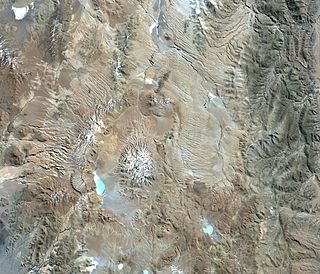
Cerro Galán is a caldera in the Catamarca Province of Argentina. It is one of the largest exposed calderas in the world. It is part of the Central Volcanic Zone of the Andes, one out of several volcanic belts found in South America. It is one of several major caldera systems in the Central Volcanic Zone, some of which are grouped into the Altiplano–Puna volcanic complex.

The Purico complex is a Pleistocene volcanic complex in Chile close to Bolivia, formed by an ignimbrite, several lava domes and stratovolcanoes and one maar. It is one of the Chilean volcanoes of the Andes, and more specifically the Chilean segment of the Central Volcanic Zone, one of the four volcanic belts which make up the Andean Volcanic Belt. The Central Volcanic Zone spans Peru, Bolivia, Chile and Argentina and includes 44 active volcanoes as well as the Altiplano-Puna volcanic complex, a system of large calderas and ignimbrites of which Purico is a member of. Licancabur to the north, La Pacana southeast and Guayaques to the east are separate volcanic systems.

La Pacana is a Miocene age caldera in northern Chile's Antofagasta Region. Part of the Central Volcanic Zone of the Andes, it is part of the Altiplano-Puna volcanic complex, a major caldera and silicic ignimbrite volcanic field. This volcanic field is located in remote regions at the Zapaleri tripoint between Chile, Bolivia and Argentina.

Kunturiri is a volcano in the Andes on the border of Bolivia and Chile which rises up to 5,762 metres (18,904 ft). On the Chilean side it is located in the Arica and Parinacota Region and on the Bolivian side in the Oruro Department, Sajama Province, Curahuara de Carangas Municipality, Sajama Canton as well as in the La Paz Department, Pacajes Province, Calacoto Municipality, Ulloma Canton.
Abra Granada is a volcanic complex in the Puna de Atacama in Bolivia. It is located approximately 45 kilometres (28 mi) north of Pirquitas and is composed from a lava dome, lavas and dacitic ignimbrites centering on Cerro Granada and are dated 9.8-7.8 Ma. Deposits erupted 7.9-5.0 mya by this volcano overlie the older Granada ignimbrite. Other peraluminous rocks were erupted 10 mya. The complex is the likely source of the Granada Ignimbrite. The ignimbrite reaches its maximum thickness in the complex.
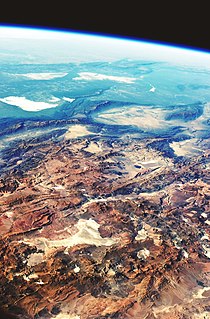
The Altiplano–Puna volcanic complex, also known as APVC, is a complex of volcanic systems in the Puna of the Andes. It is located in the Altiplano area, a highland bounded by the Bolivian Cordillera Real in the east and by the main chain of the Andes, the Western Cordillera, in the west. It results from the subduction of the Nazca Plate beneath the South American Plate. Melts caused by subduction have generated the volcanoes of the Andean Volcanic Belt including the APVC. The volcanic province is located between 21° S–24° S latitude. The APVC spans the countries of Argentina, Bolivia and Chile.
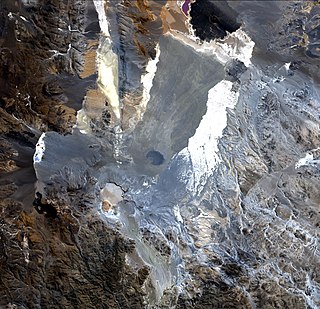
Cerro Blanco is a caldera in the Andes of the Catamarca Province in Argentina. Part of the Central Volcanic Zone of the Andes, it is a volcano collapse structure located at an altitude of 4,670 metres (15,320 ft) in a depression. The caldera is associated with a less well defined caldera to the south and several lava domes.
Tilocalar are two volcanoes in the Central Volcanic Zone of the Andes. They are constructed on Pleistocene ignimbrites and are 3.5 kilometres (2.2 mi) afar. Tilocálar Sur is a 3,116 metres (10,223 ft) high polygenetic volcano and has an explosion crater one kilometre to the south. Two other craters are also present along a graben. Four basaltic andesite-andesite lava flows emanate from it. Tilocálar Norte is a 3,040 metres (9,970 ft) high monogenetic system and generated northbound lava flows that run along the eastern wall of the Callejón de Tilocálar. Based on the age of the underlying Tucucaro ignimbrite the volcano is less than 3.2 million years old. An andesitic dyke swarm is associated with this system.

Cerro Guacha is a Miocene caldera in southwestern Bolivia's Sur Lípez Province. Part of the volcanic system of the Andes, it is considered to be part of the Central Volcanic Zone (CVZ), one of the three volcanic arcs of the Andes, and its associated Altiplano-Puna volcanic complex (APVC). A number of volcanic calderas occur within the latter.

Panizos is a Late Miocene era caldera in the Santa Cruz department of Bolivia and the Jujuy Province of Argentina. It is part of the Altiplano-Puna volcanic complex of the Central Volcanic Zone in the Andes. 50 volcanoes active in recent times are found in the Central Volcanic Zone, and several major caldera complexes are situated in the area. The caldera is located in a logistically difficult area of the Andes.
Lauca is a 5,140 metres (16,860 ft) high andesitic stratovolcano in the Central Volcanic Zone of the Andes on the Altiplano in northern Chile. Administratively it is located in Putre, Arica y Parinacota Region. The volcano was active during the Late Miocene from 10.5 million years ago onwards. A major ignimbrite collapsed the volcano in the Late Pliocene.
Chaxas is a lava dome complex which has been the source of the 1.09±0.56 mya Chaxas ignimbrite in the Andes. The ignimbrite dips away from the domes and are partially younger than the Puripicar ignimbrite. The dome has a diameter of 5 kilometres (3.1 mi) and fills the vent area of the ignimbrite. Licancabur volcano is constructed on top of this ignimbrite. Some Inka ceramics are derived from the clay in this ignimbrite.
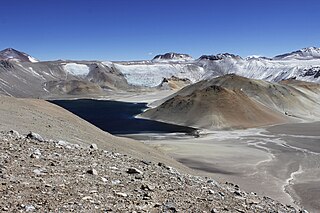
Incapillo is a Pleistocene caldera, a depression formed by the collapse of a volcano, in the La Rioja province of Argentina. Part of the Argentine Andes, it is considered the southernmost volcanic centre in the Central Volcanic Zone of the Andes with Pleistocene activity. Incapillo is one of several ignimbritic or calderic systems that, along with 44 active stratovolcanoes, are part of the Central Volcanic Zone.

Irruputuncu is a volcano in the commune of Pica, Tamarugal Province, Tarapacá Region, Chile, as well as San Pedro de Quemes Municipality, Nor Lípez Province, Potosí Department, Bolivia. The mountain's summit is 5,163 m (16,939 ft) high and has two summit craters—the southernmost 200 m (660 ft)-wide one has active fumaroles. The volcano also features lava flows, block and ash flows and several lava domes. The volcano is part of the Andean Central Volcanic Zone (CVZ).
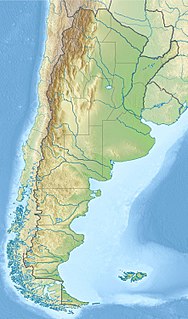
Laguna Amarga is a caldera and associated ignimbrite in the Andes of northwestern Argentina.
Chato Aislado is a volcano in Chile.
Leon Muerto is a 4,799 metres (15,745 ft) high volcano in Chile.
Los Colorados is the name of a caldera in Chile. It is part of the Central Volcanic Zone of the Andes.
Wheelwright caldera is a caldera in Chile. It is variously described as being between 11 kilometres (6.8 mi) and 22 kilometres (14 mi) wide and lies in the Central Volcanic Zone of the Andes. A lake lies within the caldera, which is among the largest of the Central Andes. The caldera lies in the region of Ojos del Salado, the world's tallest volcano.













